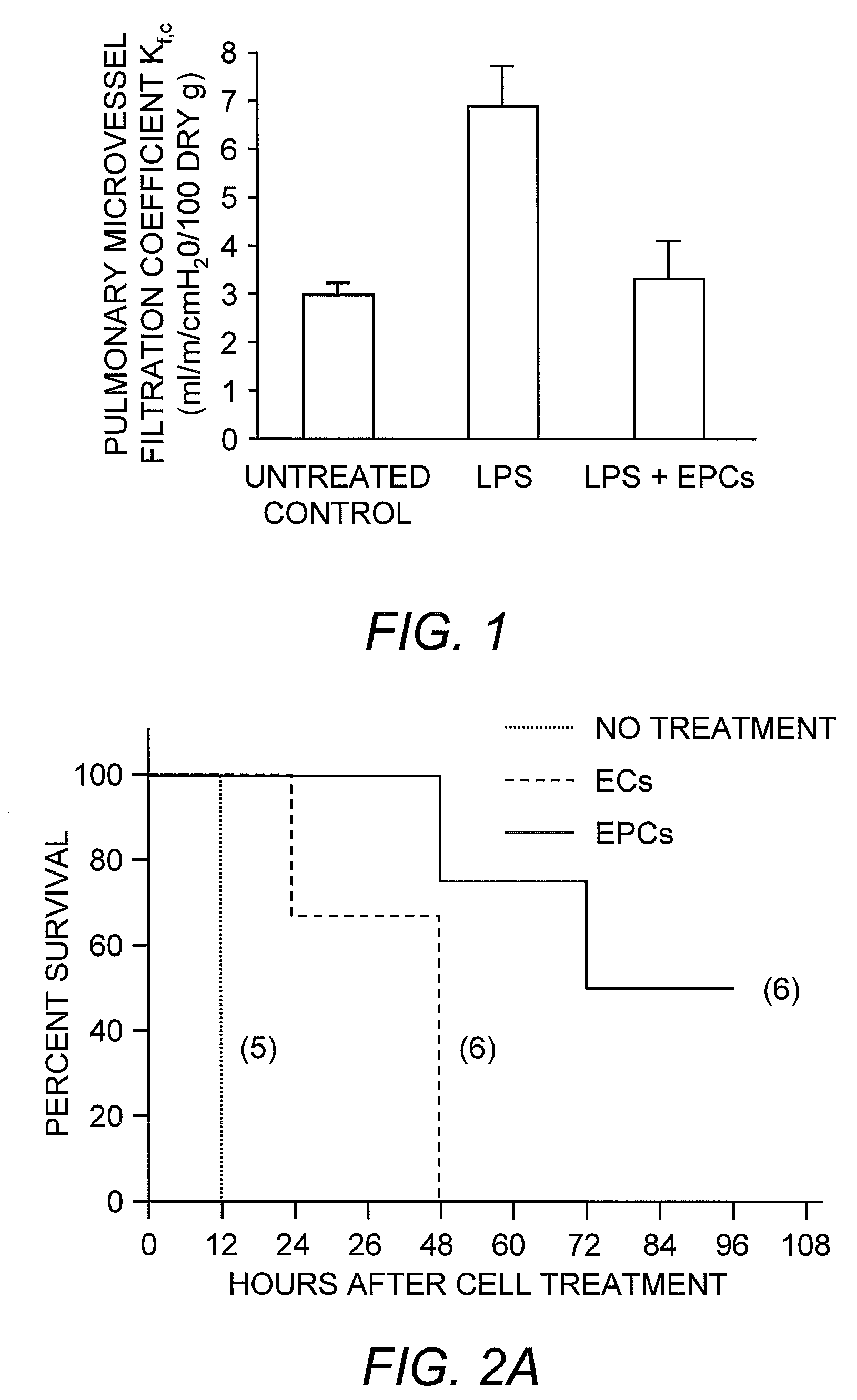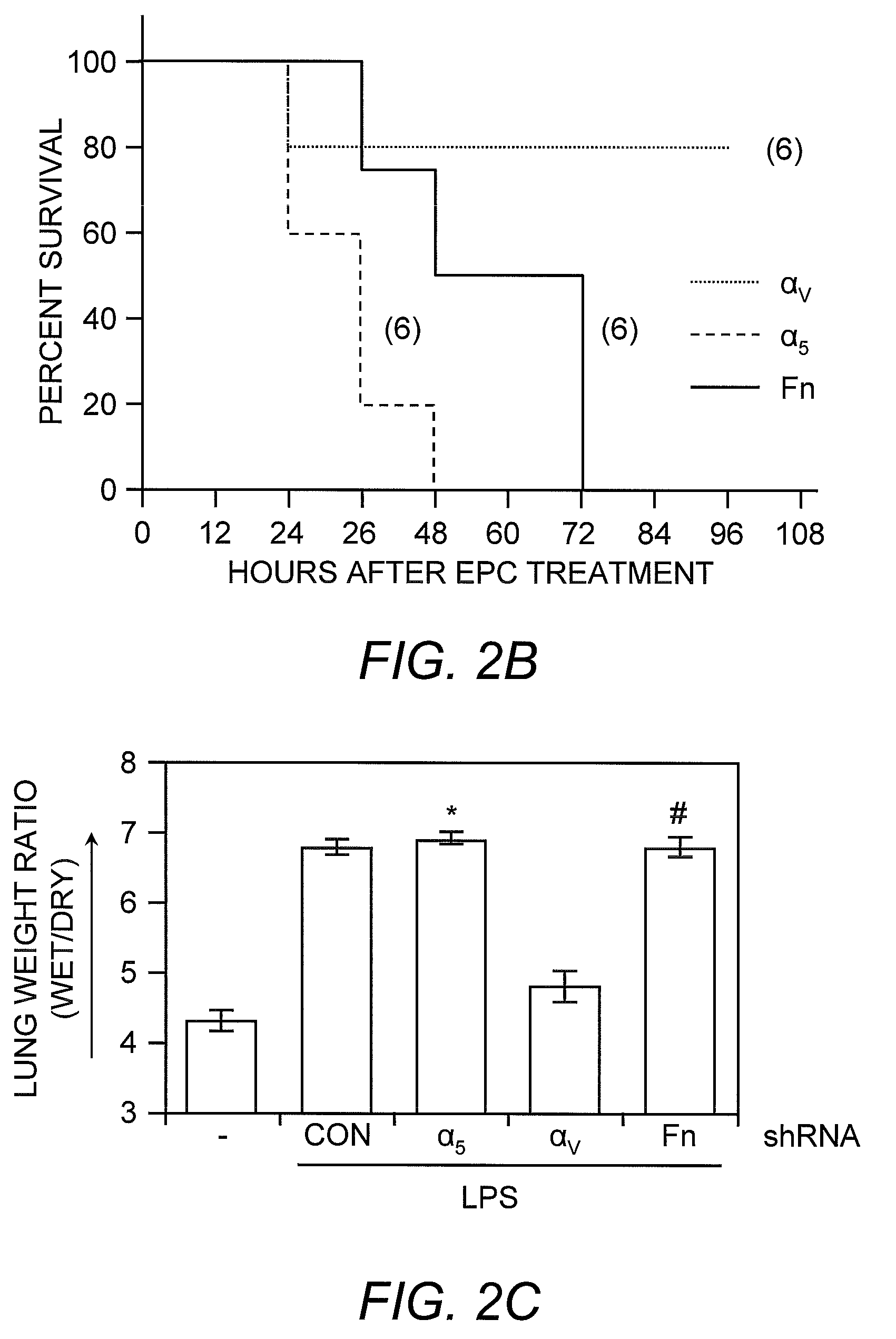Selected endothelial progenitor cells and methods for use
a technology of endothelial progenitor cells and endothelial cells, which is applied in the direction of biocide, genetic material ingredients, drug compositions, etc., can solve the problems of pulmonary edema, pulmonary inflammation, and pulmonary edema, and achieves the effects of preventing pulmonary edema, promoting wound healing and angiogenesis, and reducing the severity of lung injury
- Summary
- Abstract
- Description
- Claims
- Application Information
AI Technical Summary
Benefits of technology
Problems solved by technology
Method used
Image
Examples
example 1
Materials and Methods
[0033]Mice. C57BL / 6J mice between 7 and 10 weeks of age were purchased from Charles River (Wilmington, Mass.) and housed in a pathogen-free Biological Research Laboratory vivarium facility. Experimental procedures involving the use of mice were approved by the Institutional Animal Care Committee.
[0034]EPC Culture Medium. Sterile phosphate-buffered saline (PBS), fetal bovine serum (FBS), antibiotics, and L-glutamine were purchased from INVITROGEN (Carlsbad, Calif.). EGM-2, which is a basal endothelial cell medium that contains 2% FBS and no growth factors cytokines or supplements, was from Cambrex (East Rutherford, N.J.). Human Vascular Endothelial Growth Factor-165 (hVEGF165) was from R & D Systems (Minneapolis, Minn.). Human Vascular Endothelial Growth Factor-121 (hVEGF121) was from Sigma (St. Louis, Mo.). Gelatin (0.2%) was prepared in PBS.
[0035]Complete EPC medium was prepared with the following reagents: Endothelial growth media-2 (500 ml), FBS (25 ml, final...
example 2
Purification and Expansion of Mouse EPCs
[0050]Under an appropriate physical and chemical microenvironment, stem cells generate a diverse range of multipotent progenitor cells. These multipotent progenitor cells in turn give rise to several different limited potential progenitor cells, which produce one or more specialized differentiated cell types.
[0051]Stem cells are highly abundant and active during embryonic development, but their pool diminishes in adult life. For example, neural and endothelial progenitor cells (EPCs) are found at diminished levels in adult. However, some adult organs such as skin, intestinal epithelium, liver, and bone marrow have higher levels of self renewing stem cells. Bone marrow serves as one of the main sources for hematopoietic stem cells, as well as non-hematopoietic stem cells, from which several different progenitor cells can be isolated and expanded ex vivo.
[0052]Cell surface markers of EPCs include CD34, AC133, and Flk-1. EPCs may also express mat...
example 3
BM-Derived mEPCs Express a Subset of β1 Integrins
[0056]Several observations indicated that ex vivo-expanded mEPCs were adherent and anchorage-dependent cells. Since integrins control cell adhesion and anchorage-dependent phenotypes, the expression levels of various integrin polypeptides on the surface mEPCs was also determined. For integrin expression analysis, p3 mECs and mEPCs (15-16 days) were used in combination with specific anti-mouse (or rat) antibodies and FACS. This analysis indicated that mECs and mEPCs expressed the laminin / collagen-binding α1 and α2 integrins (which heterodimerize with β1 subunits to form α1β1 and α2β1 integrins) at comparable levels. The expression of α3 integrin, which combines with the β1 subunit to form the α3β1 integrin heterodimer that interacts with laminin-4, was also consistently observed. mECs expressed insignificant level of α4 integrin. In contrast, mEPCs expressed higher level of integrin α4. Both mECS and mEPCs expressed equivalent levels o...
PUM
| Property | Measurement | Unit |
|---|---|---|
| concentration | aaaaa | aaaaa |
| pH | aaaaa | aaaaa |
| pH | aaaaa | aaaaa |
Abstract
Description
Claims
Application Information
 Login to View More
Login to View More - R&D Engineer
- R&D Manager
- IP Professional
- Industry Leading Data Capabilities
- Powerful AI technology
- Patent DNA Extraction
Browse by: Latest US Patents, China's latest patents, Technical Efficacy Thesaurus, Application Domain, Technology Topic, Popular Technical Reports.
© 2024 PatSnap. All rights reserved.Legal|Privacy policy|Modern Slavery Act Transparency Statement|Sitemap|About US| Contact US: help@patsnap.com









